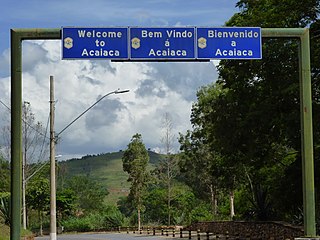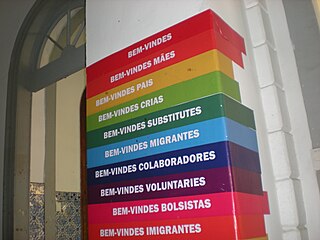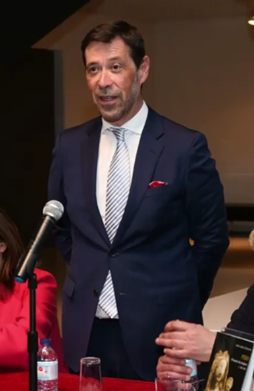
Portuguese is a Western Romance language of the Indo-European language family, originating in the Iberian Peninsula of Europe. It is an official language of Portugal, Brazil, Cape Verde, Angola, Mozambique, Guinea-Bissau and São Tomé and Príncipe, while having co-official language status in East Timor, Equatorial Guinea, and Macau. A Portuguese-speaking person or nation is referred to as "Lusophone". As the result of expansion during colonial times, a cultural presence of Portuguese speakers is also found around the world. Portuguese is part of the Ibero-Romance group that evolved from several dialects of Vulgar Latin in the medieval Kingdom of Galicia and the County of Portugal, and has kept some Celtic phonology in its lexicon.

Rabo de Peixe is a civil parish in the municipality of Ribeira Grande in the Portuguese archipelago of the Azores. The population in 2011 was 8,866, in an area of 16.96 km2. It is the most populous and most densely populated parish in the municipality. It contains the localities Charco, Custódio, Labardas, Nogueira, Pico da Madeira, Pico da Varanda, Pico do Bode, Pico do Refugio, Rebentão, Santana, São Sebastião, Senhora da Conceição and Tulha.
East Pomeranian (Ostpommersch) is a East Low German dialect moribund in Europe, which used to be spoken in the region of Farther Pomerania when it was part of the German Province of Pomerania, until World War II, and today is part of Poland. Currently, the language survives mainly in Brazil, where it is spoken by descendants of Germans expelled after the war and where it was given its own script by the linguist Ismael Tressmann. It has co-official status in 11 Brazilian municipalities and has been recognized as a historical and cultural heritage of the Brazilian state of Espírito Santo. East Pomeranian is also spoken in central Wisconsin and parts of Iowa, in the United States.

Macro-Jê is a medium-sized language family in South America, mostly in Brazil but also in the Chiquitanía region in Santa Cruz, Bolivia, as well as (formerly) in small parts of Argentina and Paraguay. It is centered on the Jê language family, with most other branches currently being single languages due to recent extinctions.

Fafe is a municipality in the northern Portuguese district of Braga. The population in 2021 was 48,502, in an area of approximately (219.08 square kilometres. The city itself had a population of 14,144 in 2001. The present mayor is Antero Barbosa, elected by the Socialist Party. The municipal holiday is May 16.

Portuguese is the official and national language of Brazil being widely spoken by most of the population. Brazil is the most populous Portuguese-speaking country in the world, with its lands comprising the majority of Portugal’s former colonial holdings in the Americas.
Sangalhos is a town and a civil parish in the municipality of Anadia, Portugal. The population in 2011 was 4,068, in an area of 16.90 km².

Luis Carlos Verzoni Nejar, better known as Carlos Nejar, is a Brazilian poet, author, translator and critic, and a member of the Academia Brasileira de Letras. One of the most important poets of its generation, Nejar, also called "o poeta do pampa brasileiro", is distinguished for his use of an extensive vocabulary, alliteration, and pandeism. His first book, Sélesis, was published in 1960.

Maracajaú é uma praia brasileira do município de Maxaranguape, Estado do Rio Grande do Norte. Está localizada a aproximadamente 50 quilômetros de Natal. Possui uma população de aproximadamente 2000 habitantes, e as principais fontes de renda são o turismo e a pesca. O nome do lugar provém do dialeto tupi (nheengatu), conforme estudo e registro de Luís da Câmara Cascudo no livro Nomes da Terra, e significa rio dos maracajás.

Luiz Fernando Ruffato de Souza is a contemporary Brazilian writer. An alumnus of the Federal University of Juiz de Fora in the Brazilian state of Minas Gerais, Ruffato worked as a journalist in São Paulo and published in several fiction books, including História dos Remorsos e Rancores (1998) and Eles Eram Muitos Cavalos (2001). The latter garnered the APCA literary prize.
The Nikkey Shimbun or the Jornal do Nikkey was a Japanese language newspaper published in Liberdade, São Paulo, Brazil. It was one of two Japanese newspapers published in that city, the other being the São Paulo Shimbun. On December 18, 2021, the newspaper printed its last edition.

Aldyr Garcia Schlee was a Brazilian writer, journalist, translator, illustrator, and professor.
Escola Suíço-Brasileira Rio de Janeiro is a Swiss international school in Barra da Tijuca, Rio de Janeiro. A part of the SIS Swiss International School network, it serves levels Educação Infantil until Ensino Médio.

A Church of the Santa Casa da Misericórdia, sometime referred to as the Church of Our Lady of Mercy, is a 17th-century church in the civil parish of Penafiel, in the municipality of the same name, in the Portuguese district of Porto.

Hirondina Joshua, is a Mozambican poet and writer. Her name translates as swallow in Latin. Member of Associação dos Escritores Moçambicanos, she is part of the new generation of Mozambican authors. She is among the 122 authors of the Brazilian project Modernos & Ternos where she "talks" to modernity in a record of the 100th anniversary of the Modern Art Week.

Ana Margarida Taborda Duarte Martins de Carvalho is a Portuguese writer and journalist. The only Portuguese writer to be award with the Grande Prémio da Associação Portuguesa de Escritores (APE/DGLB) for each of her three successive works of literary fiction; they were for two novels and a short-story collection.

Gender-neutral language in Portuguese is a recent strand of demands for greater gender equality and social inclusion between men, women and non-binary individuals. It can be divided into inclusive or non-sexist language, and non-binary or neuter language or neolanguage. Inclusive language aims to use existing words to include all genders, while neuter language uses new or modified words to accomplish this.

António Manuel Filipe Rocha Pimentel is a Portuguese academic and art historian currently the director of the Calouste Gulbenkian Museum in Lisbon, Portugal.

Miss Brazil 2016, officially Miss Brazil Be Emotion 2016, was the 62nd edition of the Miss Brazil pageant. It was held on 1 October 2016 at Citibank Hall in São Paulo, and was hosted by Cássio Reis and Daniele Suzuki with Karol Pinheiro as a backstage correspondent. Marthina Brandt of Rio Grande do Sul crowned her successor Raissa Santana of Paraná at the end of the event. Santana represented Brazil at the Miss Universe 2016 pageant and placed in the Top 13.
Turn of the Tide is a Portuguese drama television series based on a true story, created by Augusto Fraga. It follows Eduardo, a young fisherman, and his friends who find a boat full of cocaine washed up on the shore in the Azorean village of Rabo de Peixe in São Miguel Island. They decide to sell the drug, but soon they face the wrath of the drug lord who owns it, the police who are after it, and a series of unpredictable events that put their lives at risk. The series is a thrilling and realistic tale of greed, ambition and survival.

















